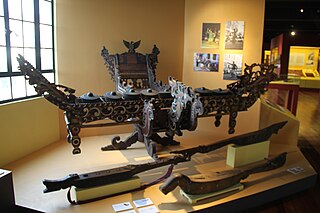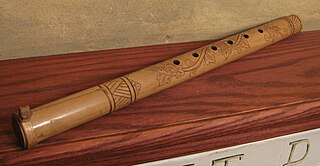
Music is the art of arranging sounds in time through the elements of melody, harmony, rhythm, and timbre. It is one of the universal cultural aspects of all human societies. General definitions of music include common elements such as pitch, rhythm, dynamics, and the sonic qualities of timbre and texture. Different styles or types of music may emphasize, de-emphasize or omit some of these elements. Music is performed with a vast range of instruments and vocal techniques ranging from singing to rapping; there are solely instrumental pieces, solely vocal pieces and pieces that combine singing and instruments. The word derives from Greek μουσική, mousiké, '(art) of the Muses'.

Music of Malaysia is the generic term for music that has been created in various genres in Malaysia. A great variety of genres in Malaysian music reflects the specific cultural groups within multiethnic Malaysian society: Malay, Chinese, Indian, Dayak, Kadazan-Dusun, Bajau, Orang Asli, Melanau, Kristang and others.

Kulintang is a modern term for an ancient instrumental form of music composed on a row of small, horizontally laid gongs that function melodically, accompanied by larger, suspended gongs and drums. As part of the larger gong-chime culture of Southeast Asia, kulintang music ensembles have been playing for many centuries in regions of the Eastern Indonesia, Southern Philippines, Eastern Malaysia, Brunei and Timor, Kulintang evolved from a simple native signaling tradition, and developed into its present form with the incorporation of knobbed gongs from Sundanese people in Java Island, Indonesia. Its importance stems from its association with the indigenous cultures that inhabited these islands prior to the influences of Hinduism, Buddhism, Islam, Christianity or the West, making Kulintang the most developed tradition of Southeast Asian archaic gong-chime ensembles.

José Íñigo Homer Lacambra Ayala, professionally known as Joey Ayala, is a Filipino singer, songwriter and former chairman of the music committee of the National Commission for Culture and the Arts. He is well known for his style of music that combines the sounds of Filipino ethnic instruments with modern pop music.

A suling or seruling is a Southeast Asian bamboo ring flute especially in Brunei, Indonesia, Malaysia, the Philippines and Singapore. It is used in Degung ensembles.

A slit drum or slit gong is a hollow percussion instrument. In spite of the name, it is not a true drum but an idiophone, usually carved or constructed from bamboo or wood into a box with one or more slits in the top. Most slit drums have one slit, though two and three slits occur. If the resultant tongues are different width or thicknesses, the drum will produce two different pitches. It is used throughout Africa, Southeast Asia, and Oceania. In Africa such drums, strategically situated for optimal acoustic transmission, have been used for long-distance communication.

The music of West Africa has a significant history, and its varied sounds reflect the wide range of influences from the area's regions and historical periods.

The agung is a set of two wide-rimmed, vertically suspended gongs used by the Maguindanao, Maranao, Sama-Bajau and Tausug people of the Philippines as a supportive instrument in kulintang ensembles. The agung is also ubiquitous among other groups found in Palawan, Panay, Mindoro, Mindanao, Sabah, Sulawesi, Sarawak and Kalimantan as an integral part of the agung orchestra.

The babandil is a single, narrow-rimmed Philippine gong used primarily as the “timekeeper” of the Maguindanao kulintang ensemble.

The dabakan is a single-headed Philippine drum, primarily used as a supportive instrument in the kulintang ensemble. Among the five main kulintang instruments, it is the only non-gong element of the Maguindanao ensemble.

The gandingan is a Philippine set of four large, hanging gongs used by the Maguindanao as part of their kulintang ensemble. When integrated into the ensemble, it functions as a secondary melodic instrument after the main melodic instrument, the kulintang. When played solo, the gandingan allows fellow Maguindanao to communicate with each other, allowing them to send messages or warnings via long distances. This ability to imitate tones of the Maguindanao language using this instrument has given the gandingan connotation: the “talking gongs.”

The kubing is a type of Philippine jaw harp from bamboo found among the Maguindanaon and other Muslim and non-Muslim tribes in the Philippines and Indonesia. It is also called kobing (Maranao), kolibau (Tingguian), aru-ding (Tagbanwa), aroding (Palawan), kulaing (Yakan), ulibaw (Kalinga), karombi (Toraja), yori (Kailinese) or Kulibaw. Ones made of sugar palm-leaf are called karinta (Munanese), ore-ore mbondu or ore Ngkale (Butonese).
The luntang is a type of Philippine xylophone of the Maguindanaon people, strung vertically, with five horizontal logs hung in ascending order arranged by pitch. The Maguindanaon refer to this instrument as a luntang while the Yakan call it a kwintangan kayo. The cylindrical logs are beaten at the edge to create sounds and can be played either solo or with two people on either side. Among the Maguindanaon, the luntang is used only for self-entertainment purposes, to keep farmers awake while at the same time keeping the birds away from the fields. Commonly used for long-distance communication some times ago by the Maguindanaon, the Yakan have taken its use a step further: using it for social interactions between sexes as well.

The palendag, also called Pulalu, Palandag (Bagobo), Pulala (Bukidnon) and Lumundeg (Banuwaen) is a type of Philippine bamboo flute, the largest one used by the Maguindanaon, a smaller type of this instrument is called the Hulakteb (Bukidnon). A lip-valley flute, it is considered the toughest of the three bamboo flutes to use because of the way one must shape one's lips against its tip to make a sound. The construction of the mouthpiece is such that the lower end is cut diagonally to accommodate the lower lip and the second diagonal cut is make for the blowing edge. Among the Bukidnon, a similar instrument with the same construction except that it is three-fourths the length of the palendag, is called the hulakteb
The kutiyapi, or kudyapi, is a Philippine two-stringed, fretted boat-lute. It is four to six feet long with nine frets made of hardened beeswax. The instrument is carved out of solid soft wood such as that from the jackfruit tree.

Dance in the Philippines has played a tremendous role in Filipino culture. From one of the oldest dated dances called the Tinikling, to other folkloric dances such as the Pandanggo, Cariñosa, and Subli, and even to more modern-day dances like the ballet, it is no doubt that dance in the Philippine setting has integrated itself in society over the course of many years and is significantly imbedded in culture. Each of these dances originated in a unique way and serve a certain purpose, showcasing how diverse Philippine dances are now.
The Suludnon, also known as the Panay-Bukidnon or Pan-ayanon, are a culturally indigenous Visayan group of people who reside in the Capiz-Lambunao mountainous area and the Antique-Iloilo mountain area of Panay in the Visayan islands of the Philippines. They are one of the two only culturally indigenous group of Visayan language-speakers in the Western Visayas, along with the, Halawodnon of Lambunao and Calinog, Iloilo and Iraynon-Bukidnon of Antique. Also, they are part of the wider Visayan ethnolinguistic group, who constitute the largest Filipino ethnolinguistic group.
Kularts is a San Francisco, California,-based non-profit organization founded in 1985. It presents contemporary and tribal Filipino arts. Its mission is to expand the understanding of American Filipino culture, through sponsoring productions and presentations in the United States. Through its programs of performances, visual arts, community dialogues, and festivals, the organization hopes to advance the spirit and integrity of ancestral Filipino art and cultures.

The tube zither is a stringed musical instrument in which a tube functions both as an instrument's neck and its soundbox. As the neck, it holds strings taut and allows them to vibrate. As a soundbox or it modifies the sound and transfers it to the open air. The instruments are among the oldest of chordophones, being "a very early stage" in the development of chordophones, and predate some of the oldest chordophones, such as the Chinese Se, zithers built on a tube split in half. Most tube zithers are made of bamboo, played today in Madagascar, India, Southeast Asia and Taiwan. Tube zithers made from other materials have been found in Europe and the United States, made from materials such as cornstalks and cactus.















